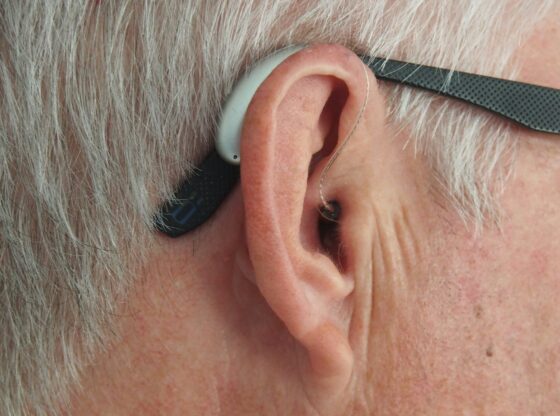Do invisible hearing aids exist that offer clarity without drawing attention? Yes, and in this article, we’ll outline the top models in the market, designed for mild to moderate hearing loss. You’ll learn how to match these discreet devices to your lifestyle and budget. Moreover you will make an informed choice to pick the best invisible hearing aids for you or your loved ones.
Table of contents
Key Takeaways
- Individuals experiencing common symptoms of hearing loss, such as asking for repetition or increasing TV volume, should seek a professional hearing evaluation to confirm their condition and explore hearing aid options. Early adoption of hearing aids is essential for a better quality of life and easier adaptation.
- Invisible hearing aids should be selected based on compatibility with the user’s level of hearing loss, their lifestyle needs, and budget considerations. They range from over-the-counter models for mild to moderate hearing loss to fully customizable prescription aids for a broader range including severe cases.
- Maintenance and care are crucial for optimizing the performance and lifespan of invisible hearing aids. Users should adopt a daily cleaning routine, troubleshoot common issues, and schedule regular professional check-ups to ensure the aids function effectively and adapt to any changes in hearing needs.
Recognizing the Signs: When You Might Need a Hearing Aid
Have you ever found yourself asking people to repeat themselves? Or, maybe, noticed that you’re turning up the TV volume higher than before? These are among the common symptoms that may signal a decline in your hearing abilities, including severe hearing loss. Recognizing these signs is the first step in reclaiming the fullness of your auditory world. Should you have suspicions about your hearing not being as good as it once was, scheduling a hearing test with a specialist is a smart move. This professional evaluation is the cornerstone of confirming any hearing loss and exploring the potential benefits of hearing aids.
After a diagnosis, the path to better hearing begins with finding the right hearing aid. This device should be tailored to your individual needs and the severity of your hearing loss, as directed by your hearing care professional. Early adoption of hearing aids is not just about amplifying sound; it’s about enhancing your quality of life. The sooner you begin to use them, the quicker you’ll adapt, resulting in a richer, more connected listening experience.
Essential Factors to Consider Before Choosing Invisible Hearing Aids
It’s important to think about several key factors before exploring the world of invisible hearing aids. These considerations ensure that your hearing aid not only fits your ear but also your lifestyle and budget. Each aspect should align with your daily activities, plays a pivotal role in selecting the perfect hearing aid for you.
Within this realm, you’ll find there’s a spectrum of options, each with its attributes. The subsections below will guide you through:
- The nuances of compatibility with your hearing loss
- The alignment of the hearing aid with your lifestyle
- The financial aspect of investing in an invisible hearing aid.
Invisible Hearing Aid Compatibility with Your Hearing Loss Level
Invisible hearing aids are typically best suited for individuals with mild to moderate hearing loss as they provide necessary amplification while remaining virtually undetectable. For the smaller types such as IIC models, achieving a custom fit is crucial for both comfort and effectiveness, ensuring the device is tailored to the unique shape of your ear canal. Invisible hearing aids effective for mild to moderate hearing loss can be found in over-the-counter (OTC) options, offering sound amplification without custom features. To understand how invisible hearing aids work, it’s important to know that they are designed to be discreet and provide the necessary amplification for those with hearing loss.
In contrast, prescription hearing aids are fully customizable and can cater to a broader range of hearing loss, including severe cases. The latest designs in invisible hearing aids have begun to challenge the norm, with some models not requiring custom ear molds, thus offering more comfort and a closer fit to the ear canal.
Lifestyle Alignment and Invisible Hearing Aids
The type of invisible hearing aid you opt for is significantly influenced by your professional and social environments, especially when wearing hearing aids. Professionals who regularly attend meetings and social events need to choose a device that adapts to different sound environments, thereby ensuring clear communication in all contexts. Take the Phonak Lyric, for instance; its extended-wear battery supports weeks of continuous use, making it an ideal companion for active individuals who prefer minimal maintenance.
Moreover, the invisible hearing aid you select should effortlessly integrate into your daily life, whether you’re an outdoor enthusiast or someone who enjoys the serenity of a quiet room. Features such as advanced noise reduction and automatic setting adjustments can significantly enhance your auditory experience, allowing you to focus more on the moment and less on managing your hearing aid.
Budgeting for Invisible Hearing Aids
Even though invisible hearing aids are often less expensive than their counterparts, careful budgeting remains a significant step in the selection process. It’s important to consider not just the initial invisible hearing aids cost but also the expected lifespan of the device, which typically ranges from 3 to 5 years. Warranty coverage is another factor, with most invisible hearing aids featuring warranties that usually extend to three years. This coverage can influence long-term budgeting, as it affects the costs associated with replacements and repairs.
With the right financial planning, you can ensure that your investment in better hearing is both practical and sustainable, allowing you to enjoy the benefits of your invisible hearing aid without financial strain. Selecting a model that balances cost with quality and longevity can provide peace of mind and continuous auditory support.
Ask a Friend
Like most of the decision we made in our life, before buying invisible hearing aids ask if a friend o someone close to you that is already using one. It’s always the best way to have a little more feedback of things he or she experience using this device. If is a good friend I will give an advice and will help you to pruchase the right one for you.
The Leaders in Discretion: 2024’s Top Invisible Hearing Aids
As the demand for discretion in hearing aids grows, 2024 has seen the rise of several top contenders that offer not only invisibility but also exceptional functionality and affordability. Some of the best invisible hearing aids among the top contenders for affordable invisible hearing aids include discreet hearing aids such as the smallest hearing aids:
- Phonak Lyric: celebrated for its complete invisibility and the convenience of continuous use without the need for battery changes, embodying the essence of a truly discreet hearing aid.
- Eargo 7: offers a nearly invisible design paired with a user-friendly app.
- Signia Silk Charge&Go IX: provides a nearly invisible design and superior sound quality.
These options ensure that users do not have to compromise on performance for the sake of discretion.
These leaders in the market, along with offerings from brands like Starkey and Oticon, have garnered high customer satisfaction and reliability, supported by positive reviews and the solid reputations of their manufacturers. Moreover, most of these companies offer trial periods, allowing users to test the devices in various conditions, ensuring that the chosen model meets their specific needs and preferences.
Tailored to Perfection: Customizable Features of Top Models
In the realm of invisible hearing aids, customization is key. Top models come equipped with advanced features such as digital signal processing and adaptive noise reduction, which ensure high sound fidelity and a more natural listening experience. This level of personalization allows users to engage in conversations and enjoy their surroundings with greater clarity and comfort.
Furthermore, wireless connectivity has become a standard feature among advanced hearing aids, offering seamless integration with smartphones, televisions, and other electronic devices. For example, the Starkey Genesis AI Custom provides a nearly invisible fit, as well as Bluetooth streaming and rechargeable batteries, showcasing the blend of discreet design and cutting-edge technology.
Comparing Performance: Sound Quality and Battery Life
When assessing the performance of invisible hearing aids, sound quality and battery life are paramount. Contrary to what some may assume, invisible hearing aids do not fall short in effectiveness compared to other styles, thanks to technological advancements. While smaller, fully-invisible models may offer less battery life than their larger in-ear counterparts, they still provide a broad range of functions and are suitable for treating various levels of hearing loss.
The quest for excellent sound quality and convenience has led to the development of rechargeable hearing aids, which eliminate the need for frequent battery replacements. These devices often include features such as background noise reduction, wind noise management, and Bluetooth streaming capabilities, contributing to a more natural sound experience for the user.
User Experiences: Testimonials on Comfort and Clarity
The true testament to the success of a hearing aid comes from the experiences of its users. Those who have chosen top invisible hearing aid models frequently speak to the comfort and clarity they provide. Custom-molded devices, for instance, are created to sit comfortably in the ear, avoiding interference with glasses or masks. Brands like Audicus are celebrated for their invisible aids that users find comfortable for daily wear and effective in settings ranging from quiet meetings to bustling environments.
Phonak Lyric users, in particular, report the following benefits of lyric hearing aids:
- A natural feel in the ear, thanks to the device’s design that offers enhanced hearing comfort
- The ability to wear the device 24/7, providing uninterrupted hearing capability
- Improved clarity, as the Lyric delivers consistent, natural sound
- The ability to engage in daily activities with confidence
Caring for Your Invisible Hearing Aids: Maintenance Tips
Regular cleaning, maintenance, and professional check-ups are necessary to ensure your invisible hearing aids continue to serve you well over time. By adhering to a consistent care routine, you can extend the lifespan of your devices and maintain their optimal performance, helping you to experience better hearing day after day.
In the subsections that follow, we’ll discuss the details of daily cleaning routines, how to address common issues that may arise, and the significance of professional care and regular check-ups. Ensuring that your invisible hearing aids are properly maintained is not only crucial for their functionality but also for the overall health of your ears.
Daily Cleaning Routines for Invisible Hearing Aids
Establishing a daily cleaning routine for your invisible hearing aids is crucial in preventing wax buildup and maintaining cleanliness. Here are the steps to follow:
- Use a soft, dry brush to gently remove wax from the microphone ports and receiver openings.
- With a clean, dry cloth, wipe the body of the hearing aid to keep it free from debris.
- Clean the domes or earpieces with a tissue daily to ensure overall hygiene and optimal sound quality.
At night, storing your hearing aids in a dehumidifier can help prevent moisture buildup, which is key to preserving their longevity and functionality. Be cautious to refrain from using alcohol wipes or soaking the aids in water, as these methods can damage the devices due to most not being waterproof.
Troubleshooting Common Issues with Invisible Hearing Aids
Encountering issues with your hearing aids can be frustrating, but many common problems can be resolved with simple troubleshooting steps. Here are some common problems and their solutions:
- Fading, choppy, or distorted sound may indicate a blockage from earwax. Clean the hearing aids and make sure there is no wax buildup.
- Moisture buildup can also cause damage to the hearing aids. Dry them thoroughly and consider using a dehumidifier or drying kit.
- Invisible hearing aids might require specific solutions for problems related to their size and positioning. Consult the manufacturer’s instructions or contact your audiologist for guidance.
- Cleanliness is vital for optimal functionality. Regularly clean the hearing aids and make sure there is no wax or debris obstructing the sound.
By following these troubleshooting steps, you can resolve many common issues with your hearing aids and ensure they function properly.
If normal function isn’t restored after self-troubleshooting, seeking professional cleaning by an audiologist is recommended. They can address sound quality issues and provide a deeper clean than might be possible at home.
Professional Care and Regular Check-Ups
While you can handle daily maintenance at home, it’s equally important to have regular professional check-ups to make sure your invisible hearing aids are functioning optimally. These check-ups, ideally done at least annually, provide an opportunity for your audiologist to adjust and recalibrate your devices, maintaining their effectiveness and customizing them to any changes in your hearing needs.
Professional cleanings, recommended every six months, can complement your daily care routine and address issues that may not be apparent to you. Regular check-ups can also detect gradual changes in your hearing or the performance of your hearing aids, which you might not notice. Procedures such as otoscopy ensure that any issues like earwax or debris that may impair hearing aid function are identified and rectified.
Summary
As we’ve explored, the journey to better hearing with invisible hearing aids is multifaceted, encompassing the recognition of signs, careful selection, and ongoing care. By understanding when you might need a hearing aid, considering key factors such as compatibility, lifestyle, and budget, and choosing from the top models of 2024, you can find the perfect unseen companion. Remember that regular maintenance and professional support are essential to getting the most out of your hearing aids, ensuring comfort, clarity, and a high quality of life.
Frequently Asked Questions
If you frequently ask others to repeat themselves, have trouble understanding conversations, or need to increase the volume on your devices, it’s important to schedule a hearing test with a specialist to determine if you may need a hearing aid.
Invisible hearing aids are generally ideal for mild-to-moderate hearing loss, but advancements in technology have made some models suitable for more severe hearing loss with prescription options offering full customization.
Yes, you can try out an invisible hearing aid during a trial period offered by many manufacturers before making a financial commitment.
To maintain your invisible hearing aids, clean them daily with a soft brush and dry cloth, use a dehumidifier regularly, and avoid alcohol wipes or water. It’s also important to schedule professional check-ups and cleanings for optimal performance
It’s recommended to have your hearing aids professionally checked at least annually for adjustments and recalibration, and consider cleanings every six months to maintain functionality and longevity.



